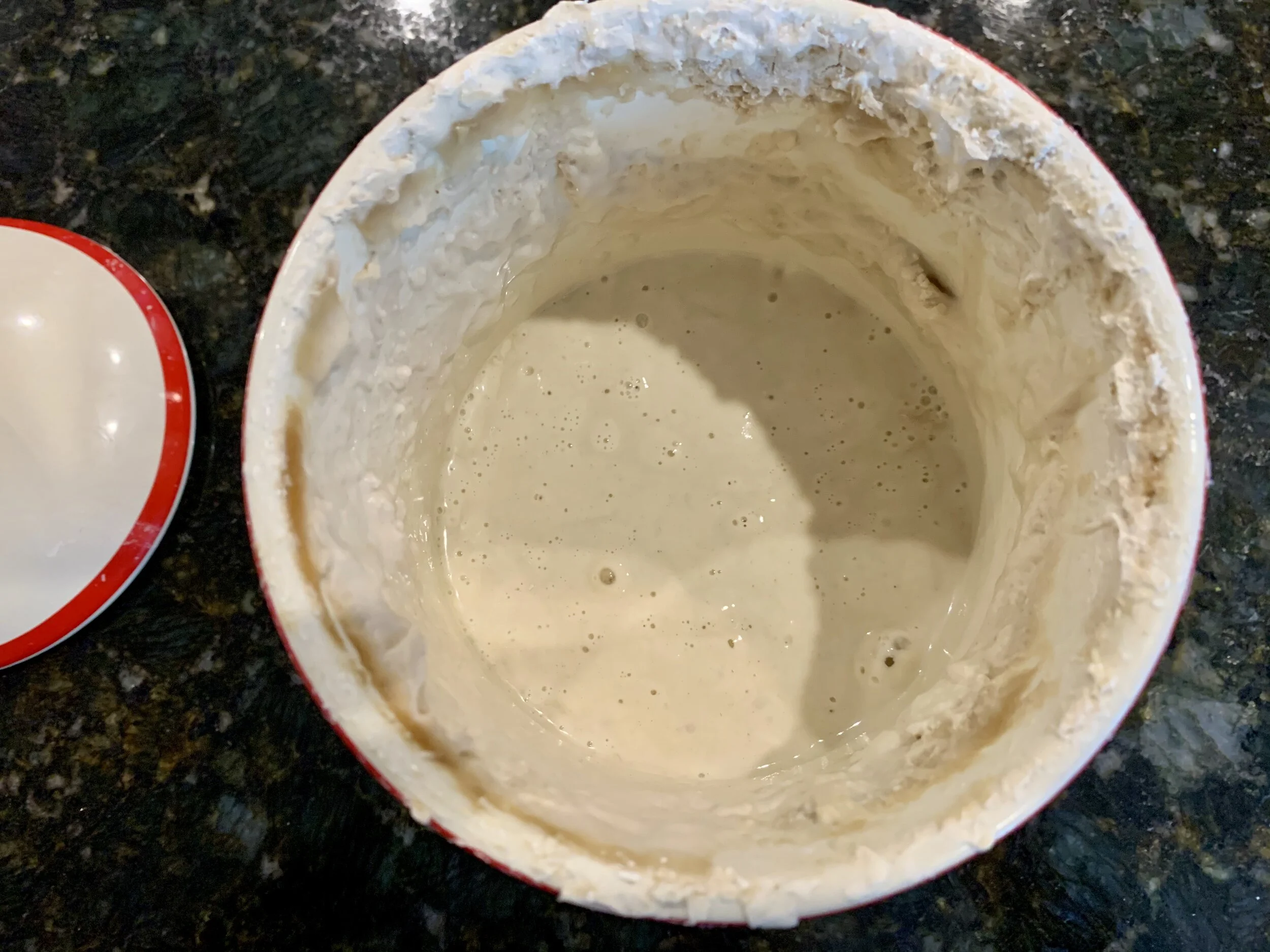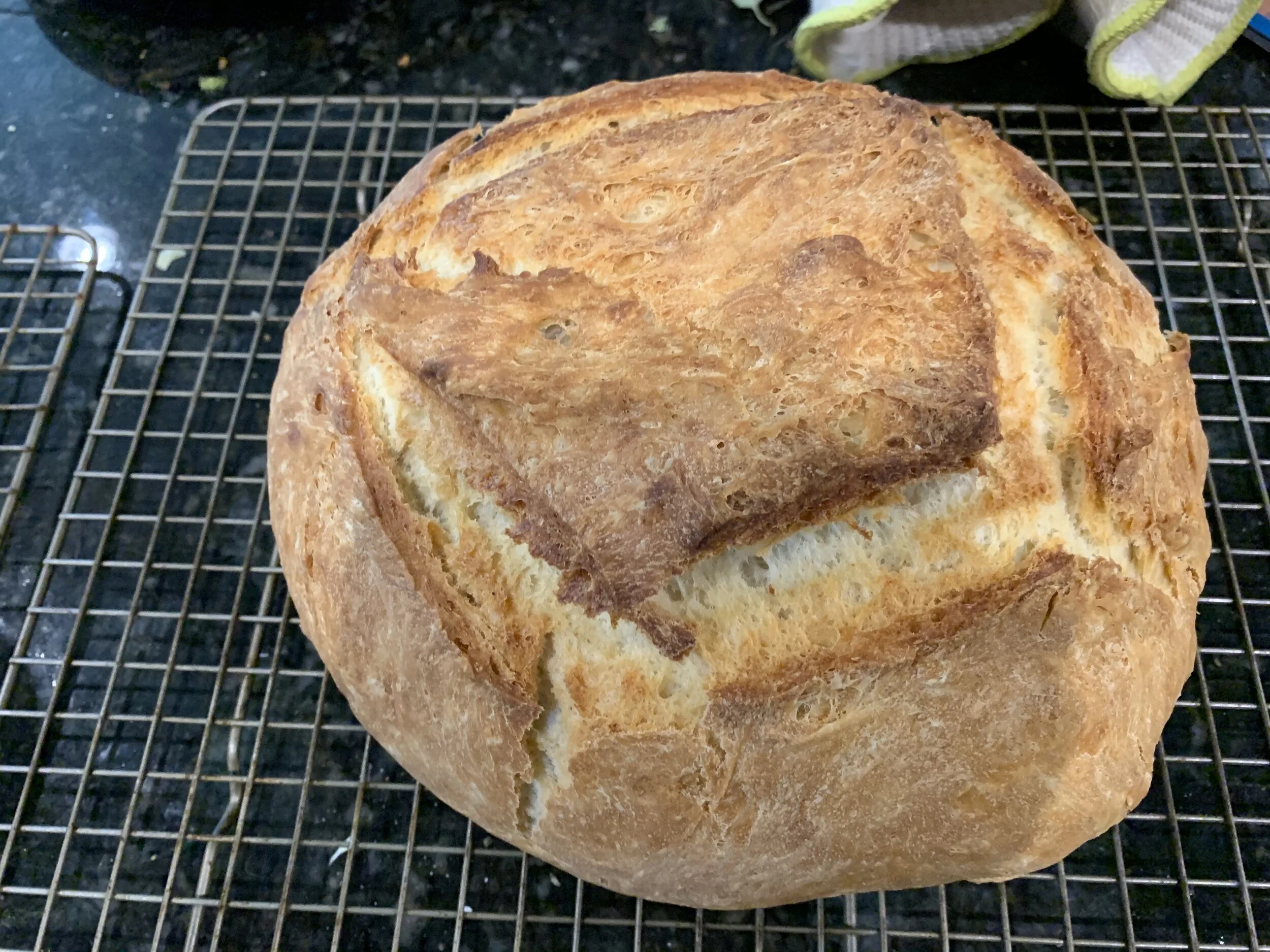Sourdough Starter
Nuts and Bolts:
Sourdough is a living creature, and it does need care. The mother, as I have heard chefs call it, can live indefinitely. When I first started to make sourdough, I was in my twenties, and I did not understand that it is a living creature, so I was not taking good care of the starter, and as a result, I failed multiple times at making sourdough bread. After years of practice and playing with sourdough, I have become much more comfortable using sourdoughs in my baking.
My thoughts on sourdough:
1. Do not rush it as you cannot speed it up. It takes its own time. I have done that so many times, and I regret it.
2. It can take months to get that amazing sourdough flavor. So hang in there.
3. You do not have to throw-out the discard. There are uses for it.
Method:
If you are new to sourdough, it is ok to buy a kit. My starter, was at some point, created from a King Arthur Baking kit. It is rather old now. I am sure it is entirely different from when I first started the mother dough. Sourdough is made of two things: water and flour. So pick flour that is of good quality. The water needs to be chlorine-free because chlorine can kill the bacteria you are trying to grow, which gives the dough a sour flavor. I use tap-water, but we have dual filter water systems, so it is pretty pure. If you are unsure how much chlorine is in your water, get bottled water to start your mother.
MOST IMPORTANT TIP: Do not get discouraged. It makes takes a few months before you get that sour flavor.
Mess Factor:
Sourdough is messy and sticky. I always rinse whatever object comes in contact with it quickly because once dry, it will become a glue that is tough to clean. But if that happens, do not panic. Just soak in hot water till it is soft and clean it out.
Final Thought:
If you store sourdough in the fridge, it lasts longer, but it does take more planning to use. How do you know if your sourdough is dead? Well, it will have a blue mold that means the starter must be thrown out. This does not happen very often. Most times, it will not come back to life even after been fed. This means that the starter does not have enough bacteria or all the bacteria is dead. So when this happens, take 1/2 cup out of the crock, wash the crock, and start over. I add a cup of flour to 1/2 cup of water. Leave it on the counter and feed it every day till it returns to life. Put it in the crock and return to using it.
So make a mess with it, Experiment!
King Arthur’s Recipe for Sourdough starter:
https://www.kingarthurbaking.com/recipes/sourdough-starter-recipe
Ingredients
To begin your starter.
1 cup flour (King Arthur recommends whole rye (pumpernickel) or whole wheat flour) I have used All-purpose
1/2 cup cool water*
Instructions:
Day 1: Combine flour with the cool water in a non-reactive container. Glass, crockery, stainless steel, or food-grade plastic all work fine for this. Make sure the container is large enough to hold your starter as it grows; we recommend at least a 1-quart capacity. Stir everything together thoroughly; make sure there's no dry flour anywhere. Cover the container loosely and let the mixture sit at warm room temperature (about 70°F) for 24 hours.
Day 2: You may see no activity at all in the first 24 hours, or you may see a bit of growth or bubbling. Either way, discard half the starter(about 1/2 cup) and add to the remainder a 1 cup All-Purpose Flour and 1/2 cup lukewarm water. Mix well, cover, and let the mixture rest at room temperature for 24 hours.
Day 3: By the third day, you'll likely see some activity — bubbling, a fresh, pungent aroma, and some evidence of expansion. It's now time to begin two feedings daily, as evenly spaced as your schedule allows. For each feeding, start by thoroughly stirring the starter, then take out a 1/2 cup. Discard any remaining starter. Add a 1 cup Unbleached all-purpose Flour and 1/2 cup water to the ½ cup of starter. Mix the starter, flour, and water, cover, and let the mixture rest at room temperature for approximately 12 hours before repeating.
Day 4: Measure our a ½ cup of starter, and discard any remaining starter. Repeat day 3.
Day 5: Measure out a ½ cup of starter Repeat step repeat day 3. By the end of day 5, the starter should have at least doubled in volume. You'll see lots of bubbles; there may be some little "rivulets" on the surface, full of finer bubbles. Also, the starter should have a tangy aroma — pleasingly acidic but not overpowering. If your starter hasn't risen much and isn't showing lots of bubbles, repeat discarding and feeding every 12 hours on day 6 and day 7, if necessary — as long as it takes to create a vigorous (risen, bubbly) starter. Hang in there; it will happen.
Once the starter is ready, give it one last feeding. Discard all 1/2 cup Feed as usual. Let the starter rest at room temperature for 6 to 8 hours; it should be active, with bubbles breaking the surface.
Remove however much starter you need for your recipe, typically no more than 227 grams, about 1 cup. If your recipe calls for more than 1 cup of starter, give it a couple of feedings without discarding until you've made enough for your recipe plus 1 cup to keep and feed again.
Transfer the remaining cup of starter to its permanent home: a crock, jar, or whatever you'd like to store it in the long-term. Feed this reserved starter with 1 scant cup (113 grams) of flour and 1/2 cup (113 grams) water, and let it rest at room temperature for several hours to get going before covering it. If you're storing the starter in a screw-top jar, screw the top on loosely rather than airtight.
Store this starter in the refrigerator and feed it regularly; we recommend feeding it with a scant 1 cup (113 grams) flour and 1/2 cup (113 grams) water once a week.


